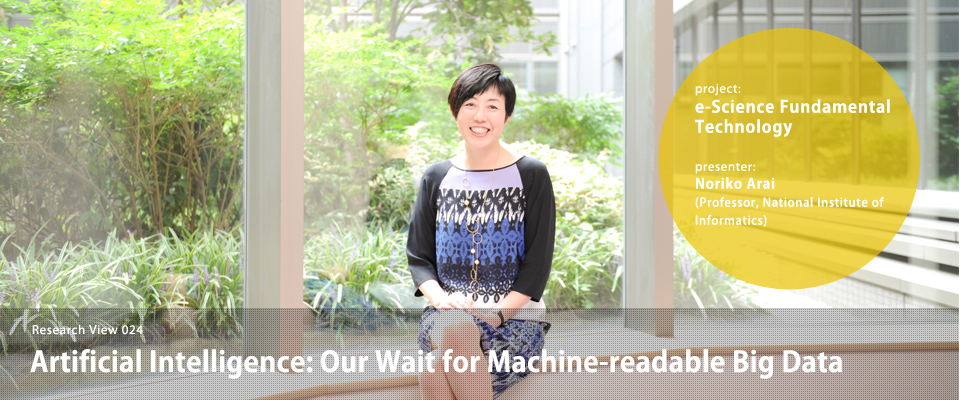
Research and development for researchmap started as "Science 2" in integrated research, immediately after the launch of the Research Organization of Information and Systems. This was released in 2009 as a system that formed the foundation of joint use by universities, providing access to budding researchers and research assistants, and accelerating collaborative research. It has continued to improve since and has grown into a comprehensive list of Japan's researchers, numbering more than 240,000 registrations. On September 16, 2015, a researchmap symposium titled “Understanding our own strengths and specialties: What should Institutional Research look like in the future?” took place at Hitotsubashi University (Chiyoda Ward in Tokyo), organized by the Japan Science and Technology Agency and the Research Organization of Information and Systems with the support of The Universities Institutional Research Consortium. “This is not just about how individual researchers can be active on a global level, but about how researchmap is needed to position Japanese research competitively in an international arena,” says Project Director Professor Noriko Arai (National Institute of Informatics). The Research Commons’ “e-science Basic Technology” project is involved in the research and development of this researchmap project. (Further information about researchmap in Japanese is available from here)
A platform for integrated research
When researchmap first started as a ROIS integrated research project, the organization that requested I deliver a guest lecture was the NSF Tokyo Regional Office (the Tokyo office of the American National Science Foundation). Although everyone had access to the website, many people at this lecture questioned the need for this and there was no understanding of the project at all. Shortly thereafter however, the Obama administration assumed power, a science policy was announced as part of the Science and Technology Policy, and a large-scale science project was created for this at NSF. When its director Julia Lane came to Japan, she viewed a demonstration of researchmap, and she indicated that this is what she had envisioned. Even now, a limited number of countries have a project similar to researchmap, which can produce a unified comprehensive list of researchers that covers an entire nation. I really want to emphasize that Japan is leading the world in creating this type of project.

Creating a machine-readable university repository
To find the type of research that is being conducted at any time, there are scholarly papers. Many universities and researchers believe it is important to publish lists of publications. However, such lists are reminiscent of the paper-based age. Research is not something that can be measured by the number of papers, and if no genuinely interested researcher clicks on a paper, and then reads it and quotes it, that paper does not gain momentum. In this sense, this is saying that “greyed out” data, which do not have any links, are of no value. A scientific platform should be a “push-type” database that leads the researcher to make more associative connections by browsing, or finding only the information of interest. For example, if we can link the information to JST databases financed by competitive funding, given that researchmap is currently run by JST, this might be a great motivator for researchers to store their own research data on researchmap.

Basic data for Science and Technology Policies and Research Strategies
With researchmap, we want to provide basic data that are useful to strategies where Japan drives research and innovation. Did a Science and Technology policy that was implemented previously really work? Underlying policies are evaluated by asking, for instance, what would happen if the number of research grants would be reduced and competitive funding increased, and by asking where the increasing number of young researchers on fixed-term contracts goes because of this. Presently, there are no data that form the basis of such evaluation. Alternatively, if this type of data were provided to universities, and each university added its institutional data, the information could be used for analyzing the universities' strengths and weaknesses. I would very much like researchmap to also be used to achieve the optimal solution for the reforms that the universities are currently being pressured to implement. In this regard, we want to become involved in information visualization technologies to facilitate viewing and analyzing data.

Easier to use still: an evolving push-type database
Thus far, researchmap has employed databases in the background and has provided useful features where researchers can enter information, such as their papers, or obtained grants-in-aid without spending much time on such activities. The research and development behind these types of easy-to-use features are conducted in partnership with Professors Takeda and Aizawa. Various functions will be enhanced in the future, including sending a notification to co-authors requesting verification as to whether a joint paper entered by one of the co-authors is also theirs, and a name aggregate function that identifies the same person and paper. We believe that we might be able to offer an interface in the next financial year to provide input support, such as displaying automated input in grey and a person's own input in bold.

(Text in Japanese: Noriko Arai, Rue Ikeya. Photographs: ERIC. Published: October 13, 2015)




